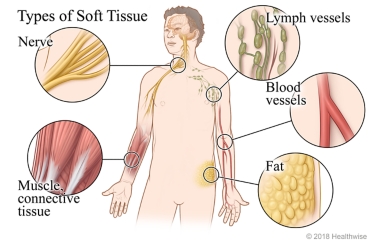What is a benign soft tissue tumor?

A soft tissue tumor is a growth of abnormal cells in the body's soft tissues. These tissues include the muscles, lymph and blood vessels, nerves, and fat. They can also include cartilage and other connective tissues. When a tumor is benign (say "bih-NYN"), that means it's not cancer. Most soft tissue tumors are benign.
Benign tumors don't spread to other tissues and organs. They usually aren't life-threatening. But they can cause problems if they grow too much, press on nerves, or cause pain.
What are some common types of these tumors?
Some common types of benign soft tissue tumors include:
- Lipomas. These tumors form from fat cells. Angiolipomas are a type of lipoma made up of fat and blood vessels.
- Nerve sheath tumors. Tumors on a nerve may include schwannomas and neurofibromas. They might need to be removed.
- Benign synovial tumors. These appear around the tendons, near the knee, hip, elbow, or shoulder. Examples include giant cell tumor of the tendon sheath and synovial chondromatosis.
- Hemangiomas. These are tumors of the blood vessels.
- Desmoid tumors. These tumors commonly appear on the shoulder, chest, back, and thighs.
- Nodular fasciitis. These are most common in the arms. They can grow quickly.
Other types of tumors may appear on the skin, belly, arms and legs, organs, and nerves.
What are the symptoms?
Sometimes a tumor can be felt as a bump under the skin. Or if the tumor is deep enough below the skin, you may not be able to feel it. You may also feel pain near the tumor if it's large or pressing on something.
How are these tumors diagnosed?
Your doctor will ask you about your symptoms and past health and will examine you. A physical exam can help your doctor diagnose some soft tissue tumors.
Your doctor may find a tumor when taking X-rays or other imaging tests for another problem.
If your doctor isn't sure what the growth is and your symptoms could be signs of a tumor, you will get some tests. The tests can help make sure it's not cancer. They can also help your doctor figure out the best treatment for the tumor.
- You may have one or more imaging tests to get a better look at the tumor. These may include:
- X-rays.
- Ultrasound tests.
- CT scan.
- MRI scan.
- You may need blood tests and lab work.
- You may need a biopsy so a sample of the tumor can be looked at under a microscope. This sample may also be used to test for biomarkers. They will help with planning treatment.
Doctors may also look at other parts of your body for other tumors.
How are they treated?
Some benign soft tissue tumors that aren't causing problems can be watched over time. Some may remain stable or go away on their own. But if the tumor causes pain, is growing larger, or affects your movement, it may need to be removed.
You may also choose to have these tumors removed if they bother you or if you don't like how they look.
Doctors may remove some tumors with surgery. In some cases, other treatments, including medicines, may be used.
Talk with your doctor or specialist about other types of treatments for the tumor. After your treatment, your doctor may want to check the area again to make sure that the growth doesn't come back.
Follow-up care is a key part of your treatment and safety. Be sure to make and go to all appointments, and contact your doctor if you are having problems. It's also a good idea to know your test results and keep a list of the medicines you take.
Current as of: October 1, 2025
Author: Ignite Healthwise, LLC Staff
Clinical Review Board
All Ignite Healthwise, LLC education is reviewed by a team that includes physicians, nurses, advanced practitioners, registered dieticians, and other healthcare professionals.

